Industry Based Project 1: Change Management Analysis Essay
VerifiedAdded on 2023/01/17
|16
|3785
|45
Essay
AI Summary
This essay delves into the complexities of change management within organizations, examining both internal and external forces that drive transformation. It identifies key barriers to successful change implementation, such as lack of employee involvement and ineffective communication strategies, and analyzes how these obstacles can hinder organizational progress. Furthermore, the essay explores the impact of change on organizational culture, highlighting how shifts in management can influence employee turnover and job security. The paper also investigates the effects of internal forces, including organizational culture and managerial personnel changes, and external forces, such as globalization and technological advancements, on the workforce and management. It concludes by emphasizing the importance of understanding and effectively managing these forces to navigate change successfully and maintain a productive and adaptable organizational environment. The essay provides valuable insights into how executives can work with transformation forces.
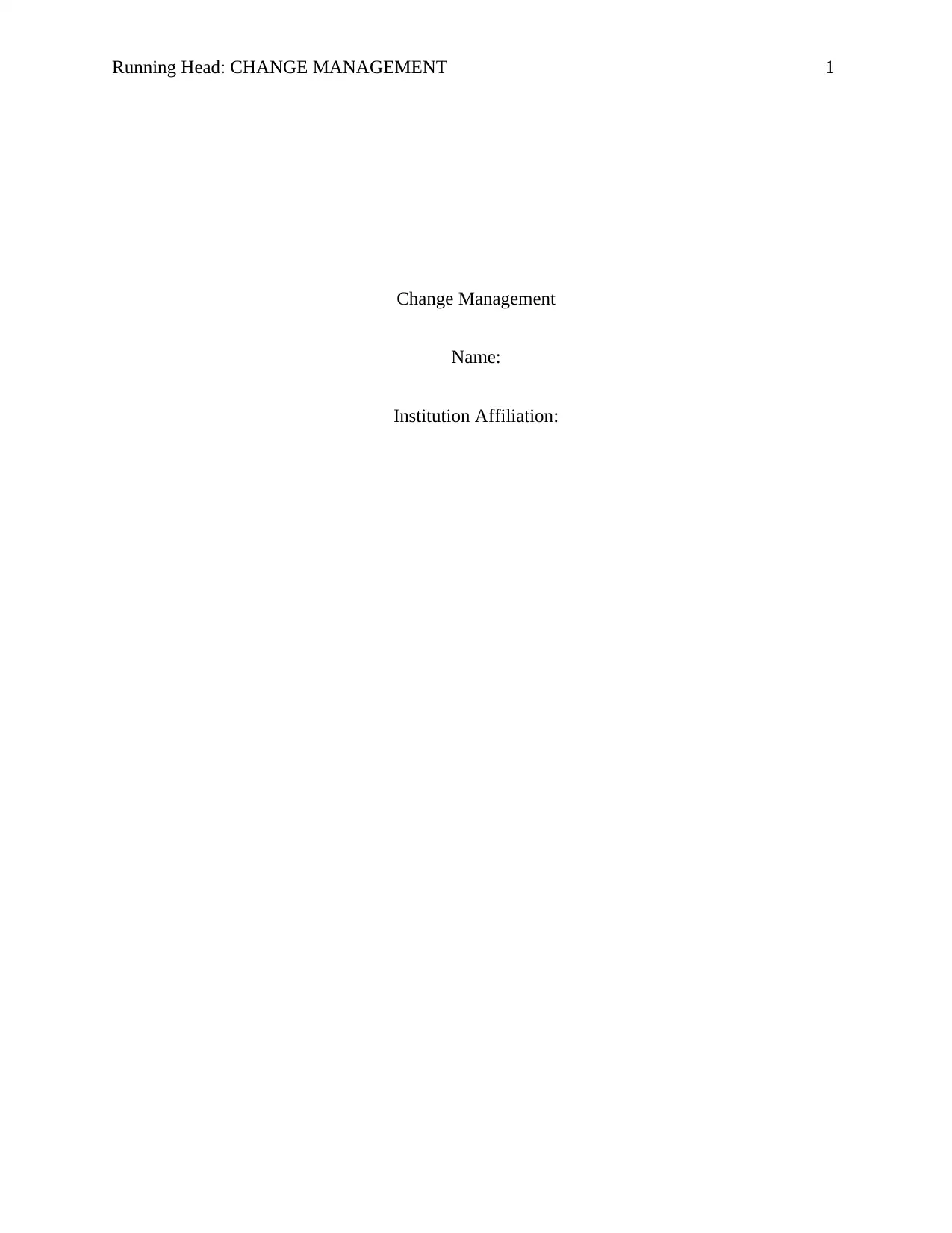
Running Head: CHANGE MANAGEMENT 1
Change Management
Name:
Institution Affiliation:
Change Management
Name:
Institution Affiliation:
Paraphrase This Document
Need a fresh take? Get an instant paraphrase of this document with our AI Paraphraser
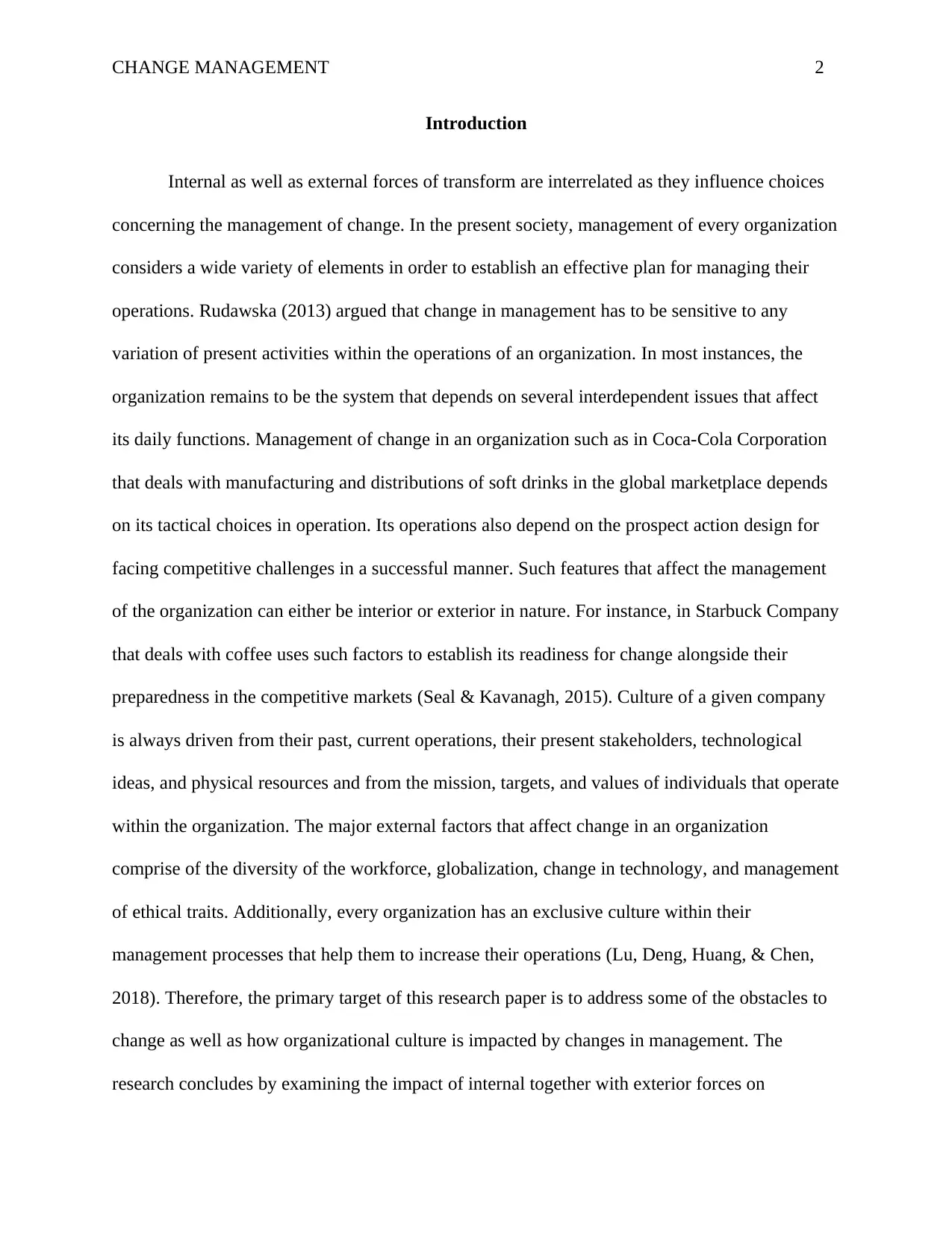
CHANGE MANAGEMENT 2
Introduction
Internal as well as external forces of transform are interrelated as they influence choices
concerning the management of change. In the present society, management of every organization
considers a wide variety of elements in order to establish an effective plan for managing their
operations. Rudawska (2013) argued that change in management has to be sensitive to any
variation of present activities within the operations of an organization. In most instances, the
organization remains to be the system that depends on several interdependent issues that affect
its daily functions. Management of change in an organization such as in Coca-Cola Corporation
that deals with manufacturing and distributions of soft drinks in the global marketplace depends
on its tactical choices in operation. Its operations also depend on the prospect action design for
facing competitive challenges in a successful manner. Such features that affect the management
of the organization can either be interior or exterior in nature. For instance, in Starbuck Company
that deals with coffee uses such factors to establish its readiness for change alongside their
preparedness in the competitive markets (Seal & Kavanagh, 2015). Culture of a given company
is always driven from their past, current operations, their present stakeholders, technological
ideas, and physical resources and from the mission, targets, and values of individuals that operate
within the organization. The major external factors that affect change in an organization
comprise of the diversity of the workforce, globalization, change in technology, and management
of ethical traits. Additionally, every organization has an exclusive culture within their
management processes that help them to increase their operations (Lu, Deng, Huang, & Chen,
2018). Therefore, the primary target of this research paper is to address some of the obstacles to
change as well as how organizational culture is impacted by changes in management. The
research concludes by examining the impact of internal together with exterior forces on
Introduction
Internal as well as external forces of transform are interrelated as they influence choices
concerning the management of change. In the present society, management of every organization
considers a wide variety of elements in order to establish an effective plan for managing their
operations. Rudawska (2013) argued that change in management has to be sensitive to any
variation of present activities within the operations of an organization. In most instances, the
organization remains to be the system that depends on several interdependent issues that affect
its daily functions. Management of change in an organization such as in Coca-Cola Corporation
that deals with manufacturing and distributions of soft drinks in the global marketplace depends
on its tactical choices in operation. Its operations also depend on the prospect action design for
facing competitive challenges in a successful manner. Such features that affect the management
of the organization can either be interior or exterior in nature. For instance, in Starbuck Company
that deals with coffee uses such factors to establish its readiness for change alongside their
preparedness in the competitive markets (Seal & Kavanagh, 2015). Culture of a given company
is always driven from their past, current operations, their present stakeholders, technological
ideas, and physical resources and from the mission, targets, and values of individuals that operate
within the organization. The major external factors that affect change in an organization
comprise of the diversity of the workforce, globalization, change in technology, and management
of ethical traits. Additionally, every organization has an exclusive culture within their
management processes that help them to increase their operations (Lu, Deng, Huang, & Chen,
2018). Therefore, the primary target of this research paper is to address some of the obstacles to
change as well as how organizational culture is impacted by changes in management. The
research concludes by examining the impact of internal together with exterior forces on
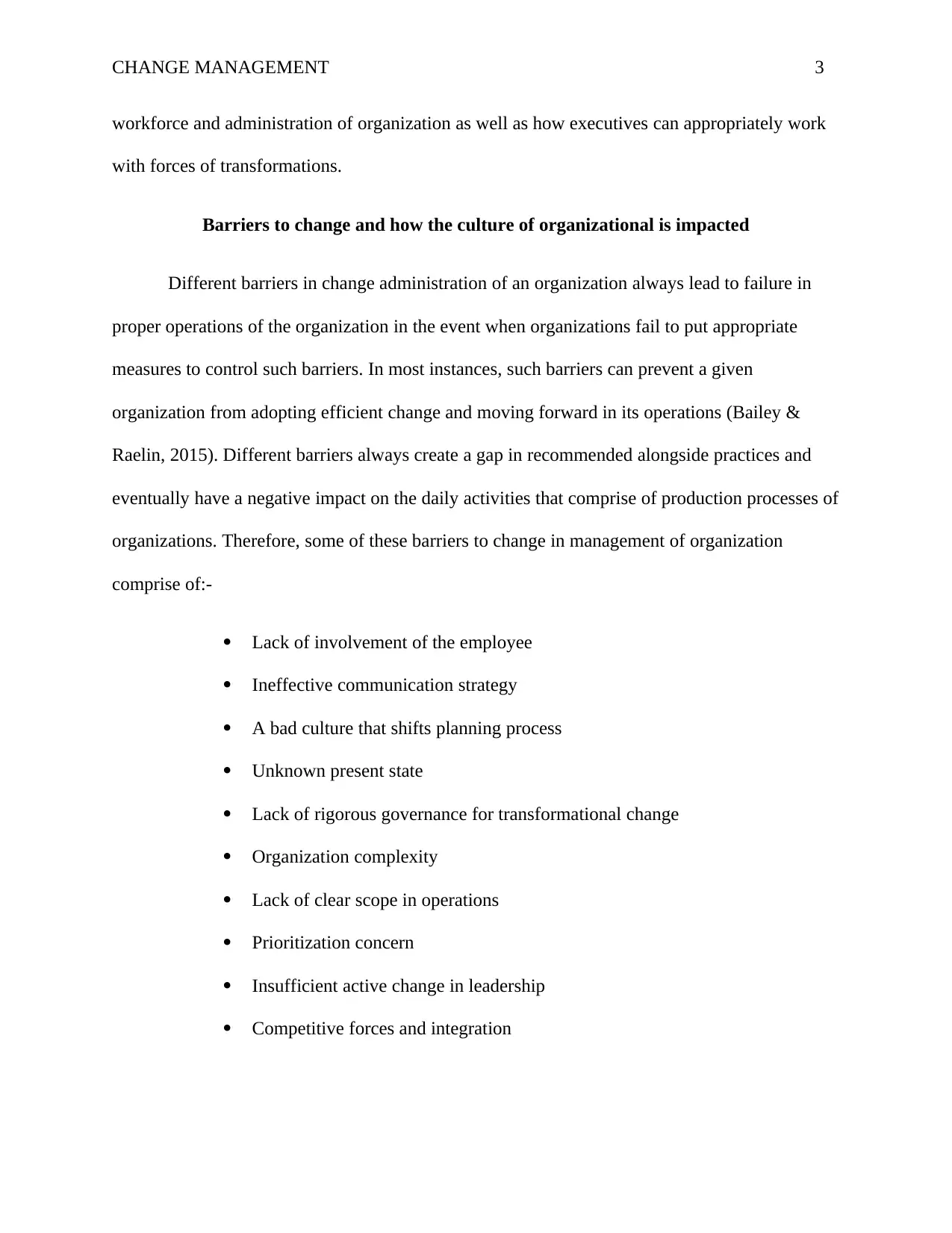
CHANGE MANAGEMENT 3
workforce and administration of organization as well as how executives can appropriately work
with forces of transformations.
Barriers to change and how the culture of organizational is impacted
Different barriers in change administration of an organization always lead to failure in
proper operations of the organization in the event when organizations fail to put appropriate
measures to control such barriers. In most instances, such barriers can prevent a given
organization from adopting efficient change and moving forward in its operations (Bailey &
Raelin, 2015). Different barriers always create a gap in recommended alongside practices and
eventually have a negative impact on the daily activities that comprise of production processes of
organizations. Therefore, some of these barriers to change in management of organization
comprise of:-
Lack of involvement of the employee
Ineffective communication strategy
A bad culture that shifts planning process
Unknown present state
Lack of rigorous governance for transformational change
Organization complexity
Lack of clear scope in operations
Prioritization concern
Insufficient active change in leadership
Competitive forces and integration
workforce and administration of organization as well as how executives can appropriately work
with forces of transformations.
Barriers to change and how the culture of organizational is impacted
Different barriers in change administration of an organization always lead to failure in
proper operations of the organization in the event when organizations fail to put appropriate
measures to control such barriers. In most instances, such barriers can prevent a given
organization from adopting efficient change and moving forward in its operations (Bailey &
Raelin, 2015). Different barriers always create a gap in recommended alongside practices and
eventually have a negative impact on the daily activities that comprise of production processes of
organizations. Therefore, some of these barriers to change in management of organization
comprise of:-
Lack of involvement of the employee
Ineffective communication strategy
A bad culture that shifts planning process
Unknown present state
Lack of rigorous governance for transformational change
Organization complexity
Lack of clear scope in operations
Prioritization concern
Insufficient active change in leadership
Competitive forces and integration
⊘ This is a preview!⊘
Do you want full access?
Subscribe today to unlock all pages.

Trusted by 1+ million students worldwide
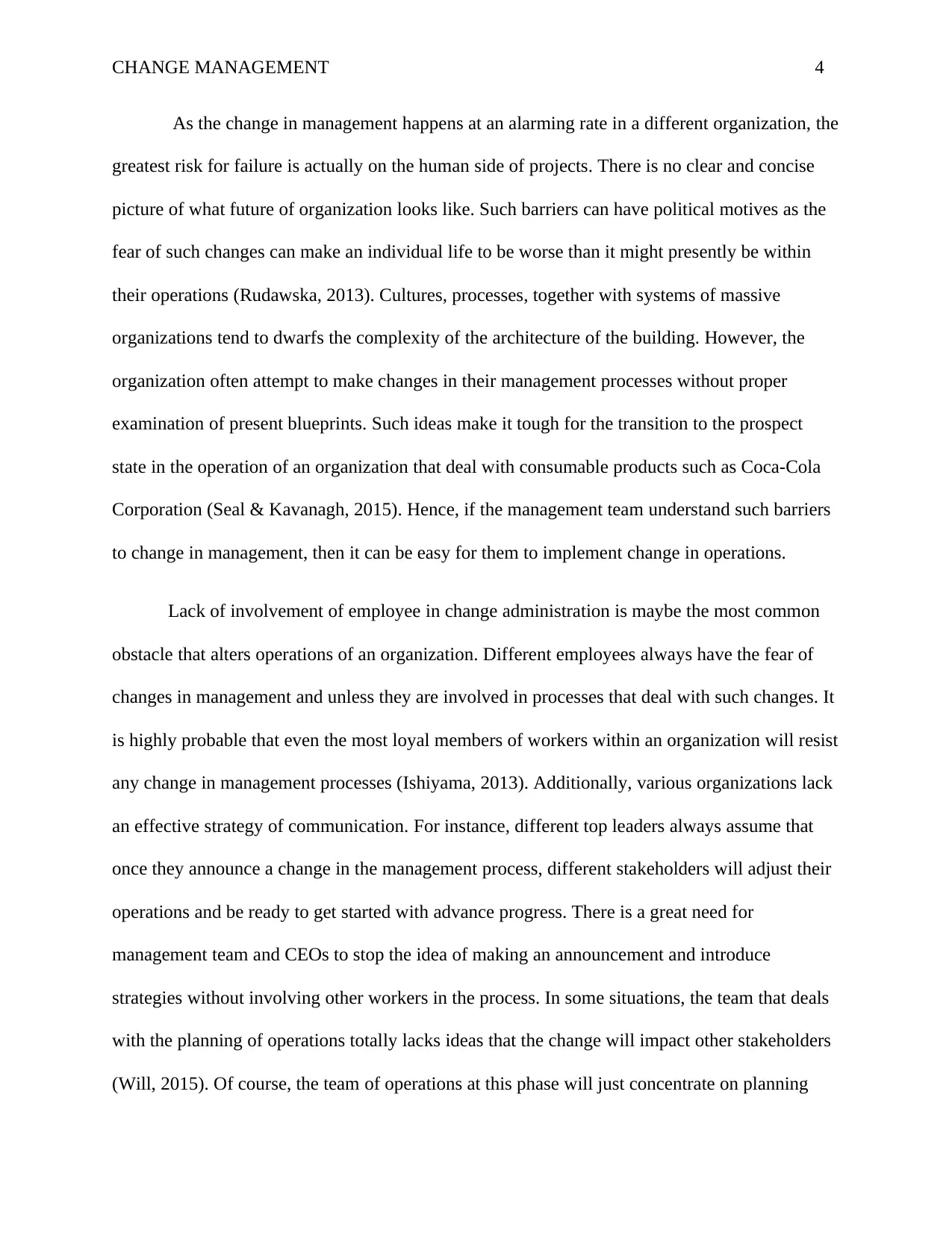
CHANGE MANAGEMENT 4
As the change in management happens at an alarming rate in a different organization, the
greatest risk for failure is actually on the human side of projects. There is no clear and concise
picture of what future of organization looks like. Such barriers can have political motives as the
fear of such changes can make an individual life to be worse than it might presently be within
their operations (Rudawska, 2013). Cultures, processes, together with systems of massive
organizations tend to dwarfs the complexity of the architecture of the building. However, the
organization often attempt to make changes in their management processes without proper
examination of present blueprints. Such ideas make it tough for the transition to the prospect
state in the operation of an organization that deal with consumable products such as Coca-Cola
Corporation (Seal & Kavanagh, 2015). Hence, if the management team understand such barriers
to change in management, then it can be easy for them to implement change in operations.
Lack of involvement of employee in change administration is maybe the most common
obstacle that alters operations of an organization. Different employees always have the fear of
changes in management and unless they are involved in processes that deal with such changes. It
is highly probable that even the most loyal members of workers within an organization will resist
any change in management processes (Ishiyama, 2013). Additionally, various organizations lack
an effective strategy of communication. For instance, different top leaders always assume that
once they announce a change in the management process, different stakeholders will adjust their
operations and be ready to get started with advance progress. There is a great need for
management team and CEOs to stop the idea of making an announcement and introduce
strategies without involving other workers in the process. In some situations, the team that deals
with the planning of operations totally lacks ideas that the change will impact other stakeholders
(Will, 2015). Of course, the team of operations at this phase will just concentrate on planning
As the change in management happens at an alarming rate in a different organization, the
greatest risk for failure is actually on the human side of projects. There is no clear and concise
picture of what future of organization looks like. Such barriers can have political motives as the
fear of such changes can make an individual life to be worse than it might presently be within
their operations (Rudawska, 2013). Cultures, processes, together with systems of massive
organizations tend to dwarfs the complexity of the architecture of the building. However, the
organization often attempt to make changes in their management processes without proper
examination of present blueprints. Such ideas make it tough for the transition to the prospect
state in the operation of an organization that deal with consumable products such as Coca-Cola
Corporation (Seal & Kavanagh, 2015). Hence, if the management team understand such barriers
to change in management, then it can be easy for them to implement change in operations.
Lack of involvement of employee in change administration is maybe the most common
obstacle that alters operations of an organization. Different employees always have the fear of
changes in management and unless they are involved in processes that deal with such changes. It
is highly probable that even the most loyal members of workers within an organization will resist
any change in management processes (Ishiyama, 2013). Additionally, various organizations lack
an effective strategy of communication. For instance, different top leaders always assume that
once they announce a change in the management process, different stakeholders will adjust their
operations and be ready to get started with advance progress. There is a great need for
management team and CEOs to stop the idea of making an announcement and introduce
strategies without involving other workers in the process. In some situations, the team that deals
with the planning of operations totally lacks ideas that the change will impact other stakeholders
(Will, 2015). Of course, the team of operations at this phase will just concentrate on planning
Paraphrase This Document
Need a fresh take? Get an instant paraphrase of this document with our AI Paraphraser
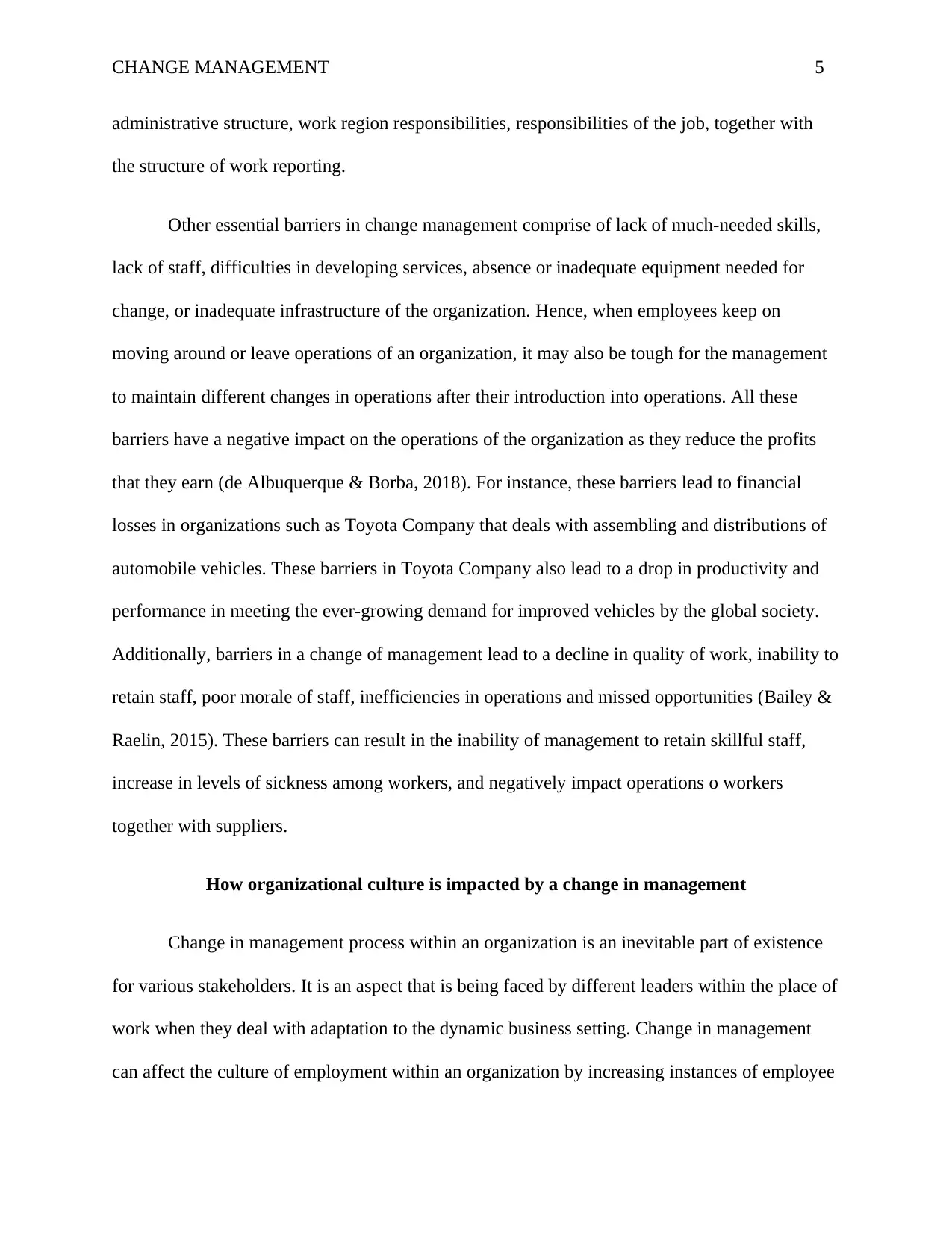
CHANGE MANAGEMENT 5
administrative structure, work region responsibilities, responsibilities of the job, together with
the structure of work reporting.
Other essential barriers in change management comprise of lack of much-needed skills,
lack of staff, difficulties in developing services, absence or inadequate equipment needed for
change, or inadequate infrastructure of the organization. Hence, when employees keep on
moving around or leave operations of an organization, it may also be tough for the management
to maintain different changes in operations after their introduction into operations. All these
barriers have a negative impact on the operations of the organization as they reduce the profits
that they earn (de Albuquerque & Borba, 2018). For instance, these barriers lead to financial
losses in organizations such as Toyota Company that deals with assembling and distributions of
automobile vehicles. These barriers in Toyota Company also lead to a drop in productivity and
performance in meeting the ever-growing demand for improved vehicles by the global society.
Additionally, barriers in a change of management lead to a decline in quality of work, inability to
retain staff, poor morale of staff, inefficiencies in operations and missed opportunities (Bailey &
Raelin, 2015). These barriers can result in the inability of management to retain skillful staff,
increase in levels of sickness among workers, and negatively impact operations o workers
together with suppliers.
How organizational culture is impacted by a change in management
Change in management process within an organization is an inevitable part of existence
for various stakeholders. It is an aspect that is being faced by different leaders within the place of
work when they deal with adaptation to the dynamic business setting. Change in management
can affect the culture of employment within an organization by increasing instances of employee
administrative structure, work region responsibilities, responsibilities of the job, together with
the structure of work reporting.
Other essential barriers in change management comprise of lack of much-needed skills,
lack of staff, difficulties in developing services, absence or inadequate equipment needed for
change, or inadequate infrastructure of the organization. Hence, when employees keep on
moving around or leave operations of an organization, it may also be tough for the management
to maintain different changes in operations after their introduction into operations. All these
barriers have a negative impact on the operations of the organization as they reduce the profits
that they earn (de Albuquerque & Borba, 2018). For instance, these barriers lead to financial
losses in organizations such as Toyota Company that deals with assembling and distributions of
automobile vehicles. These barriers in Toyota Company also lead to a drop in productivity and
performance in meeting the ever-growing demand for improved vehicles by the global society.
Additionally, barriers in a change of management lead to a decline in quality of work, inability to
retain staff, poor morale of staff, inefficiencies in operations and missed opportunities (Bailey &
Raelin, 2015). These barriers can result in the inability of management to retain skillful staff,
increase in levels of sickness among workers, and negatively impact operations o workers
together with suppliers.
How organizational culture is impacted by a change in management
Change in management process within an organization is an inevitable part of existence
for various stakeholders. It is an aspect that is being faced by different leaders within the place of
work when they deal with adaptation to the dynamic business setting. Change in management
can affect the culture of employment within an organization by increasing instances of employee
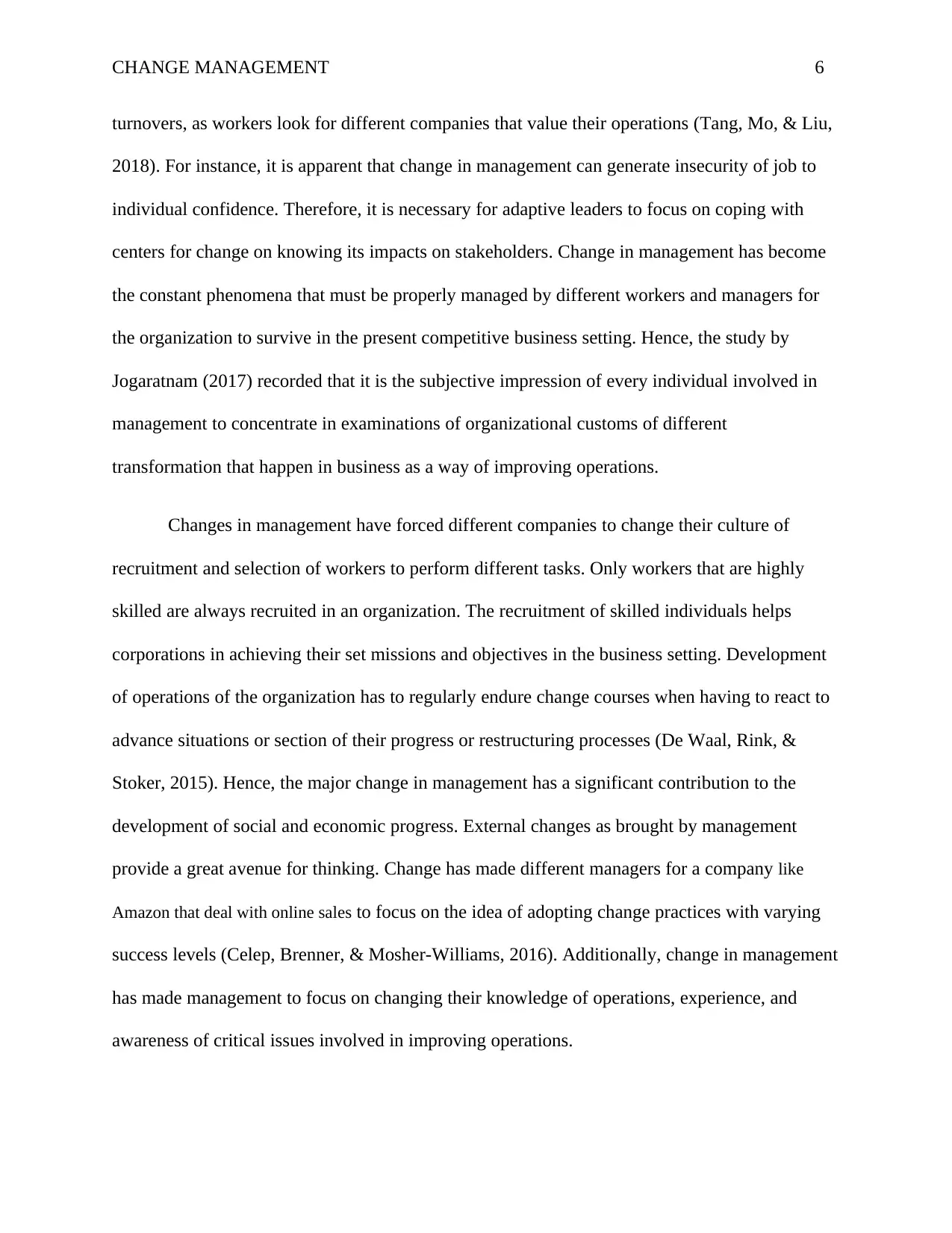
CHANGE MANAGEMENT 6
turnovers, as workers look for different companies that value their operations (Tang, Mo, & Liu,
2018). For instance, it is apparent that change in management can generate insecurity of job to
individual confidence. Therefore, it is necessary for adaptive leaders to focus on coping with
centers for change on knowing its impacts on stakeholders. Change in management has become
the constant phenomena that must be properly managed by different workers and managers for
the organization to survive in the present competitive business setting. Hence, the study by
Jogaratnam (2017) recorded that it is the subjective impression of every individual involved in
management to concentrate in examinations of organizational customs of different
transformation that happen in business as a way of improving operations.
Changes in management have forced different companies to change their culture of
recruitment and selection of workers to perform different tasks. Only workers that are highly
skilled are always recruited in an organization. The recruitment of skilled individuals helps
corporations in achieving their set missions and objectives in the business setting. Development
of operations of the organization has to regularly endure change courses when having to react to
advance situations or section of their progress or restructuring processes (De Waal, Rink, &
Stoker, 2015). Hence, the major change in management has a significant contribution to the
development of social and economic progress. External changes as brought by management
provide a great avenue for thinking. Change has made different managers for a company like
Amazon that deal with online sales to focus on the idea of adopting change practices with varying
success levels (Celep, Brenner, & Mosher-Williams, 2016). Additionally, change in management
has made management to focus on changing their knowledge of operations, experience, and
awareness of critical issues involved in improving operations.
turnovers, as workers look for different companies that value their operations (Tang, Mo, & Liu,
2018). For instance, it is apparent that change in management can generate insecurity of job to
individual confidence. Therefore, it is necessary for adaptive leaders to focus on coping with
centers for change on knowing its impacts on stakeholders. Change in management has become
the constant phenomena that must be properly managed by different workers and managers for
the organization to survive in the present competitive business setting. Hence, the study by
Jogaratnam (2017) recorded that it is the subjective impression of every individual involved in
management to concentrate in examinations of organizational customs of different
transformation that happen in business as a way of improving operations.
Changes in management have forced different companies to change their culture of
recruitment and selection of workers to perform different tasks. Only workers that are highly
skilled are always recruited in an organization. The recruitment of skilled individuals helps
corporations in achieving their set missions and objectives in the business setting. Development
of operations of the organization has to regularly endure change courses when having to react to
advance situations or section of their progress or restructuring processes (De Waal, Rink, &
Stoker, 2015). Hence, the major change in management has a significant contribution to the
development of social and economic progress. External changes as brought by management
provide a great avenue for thinking. Change has made different managers for a company like
Amazon that deal with online sales to focus on the idea of adopting change practices with varying
success levels (Celep, Brenner, & Mosher-Williams, 2016). Additionally, change in management
has made management to focus on changing their knowledge of operations, experience, and
awareness of critical issues involved in improving operations.
⊘ This is a preview!⊘
Do you want full access?
Subscribe today to unlock all pages.

Trusted by 1+ million students worldwide
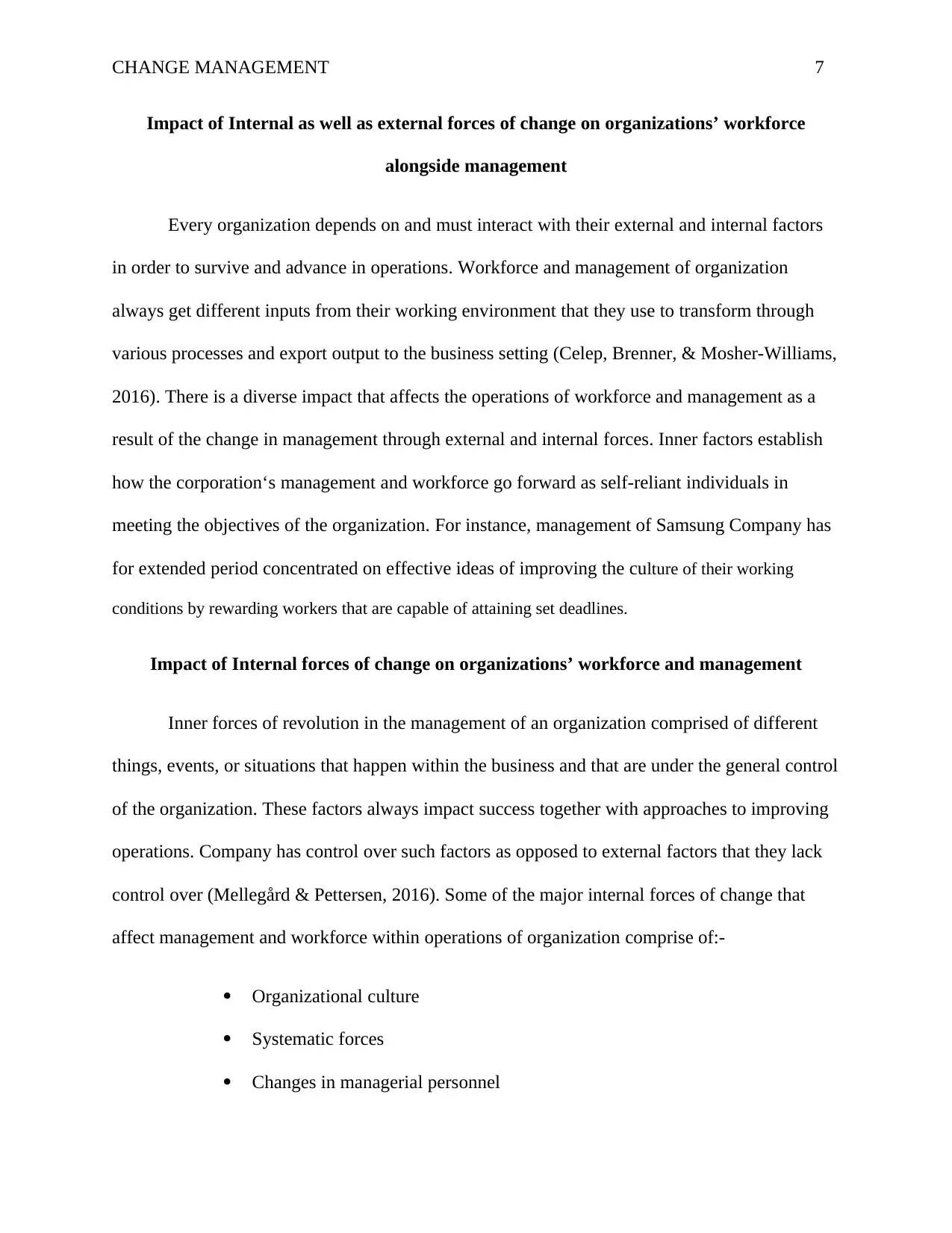
CHANGE MANAGEMENT 7
Impact of Internal as well as external forces of change on organizations’ workforce
alongside management
Every organization depends on and must interact with their external and internal factors
in order to survive and advance in operations. Workforce and management of organization
always get different inputs from their working environment that they use to transform through
various processes and export output to the business setting (Celep, Brenner, & Mosher-Williams,
2016). There is a diverse impact that affects the operations of workforce and management as a
result of the change in management through external and internal forces. Inner factors establish
how the corporation‘s management and workforce go forward as self-reliant individuals in
meeting the objectives of the organization. For instance, management of Samsung Company has
for extended period concentrated on effective ideas of improving the culture of their working
conditions by rewarding workers that are capable of attaining set deadlines.
Impact of Internal forces of change on organizations’ workforce and management
Inner forces of revolution in the management of an organization comprised of different
things, events, or situations that happen within the business and that are under the general control
of the organization. These factors always impact success together with approaches to improving
operations. Company has control over such factors as opposed to external factors that they lack
control over (Mellegård & Pettersen, 2016). Some of the major internal forces of change that
affect management and workforce within operations of organization comprise of:-
Organizational culture
Systematic forces
Changes in managerial personnel
Impact of Internal as well as external forces of change on organizations’ workforce
alongside management
Every organization depends on and must interact with their external and internal factors
in order to survive and advance in operations. Workforce and management of organization
always get different inputs from their working environment that they use to transform through
various processes and export output to the business setting (Celep, Brenner, & Mosher-Williams,
2016). There is a diverse impact that affects the operations of workforce and management as a
result of the change in management through external and internal forces. Inner factors establish
how the corporation‘s management and workforce go forward as self-reliant individuals in
meeting the objectives of the organization. For instance, management of Samsung Company has
for extended period concentrated on effective ideas of improving the culture of their working
conditions by rewarding workers that are capable of attaining set deadlines.
Impact of Internal forces of change on organizations’ workforce and management
Inner forces of revolution in the management of an organization comprised of different
things, events, or situations that happen within the business and that are under the general control
of the organization. These factors always impact success together with approaches to improving
operations. Company has control over such factors as opposed to external factors that they lack
control over (Mellegård & Pettersen, 2016). Some of the major internal forces of change that
affect management and workforce within operations of organization comprise of:-
Organizational culture
Systematic forces
Changes in managerial personnel
Paraphrase This Document
Need a fresh take? Get an instant paraphrase of this document with our AI Paraphraser
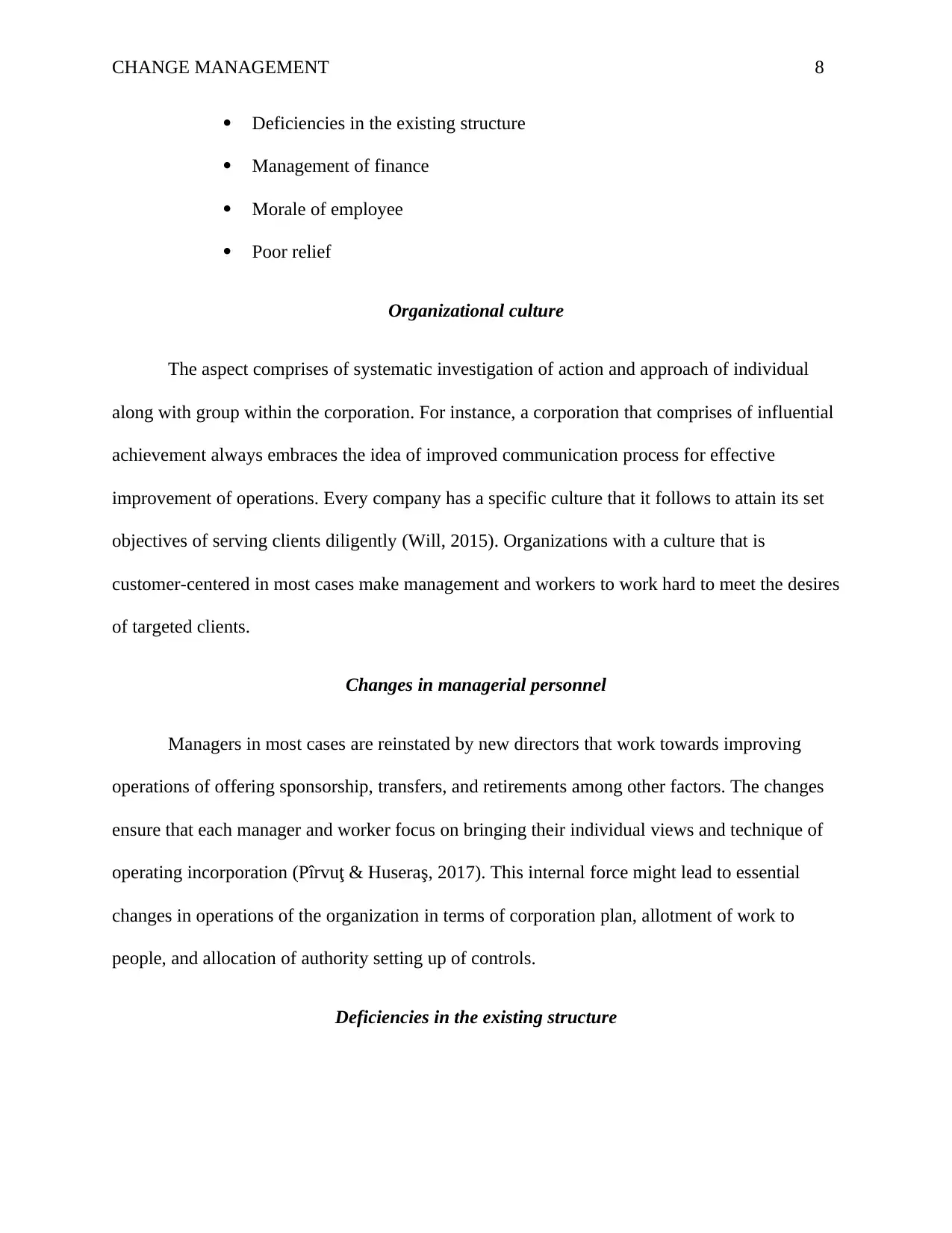
CHANGE MANAGEMENT 8
Deficiencies in the existing structure
Management of finance
Morale of employee
Poor relief
Organizational culture
The aspect comprises of systematic investigation of action and approach of individual
along with group within the corporation. For instance, a corporation that comprises of influential
achievement always embraces the idea of improved communication process for effective
improvement of operations. Every company has a specific culture that it follows to attain its set
objectives of serving clients diligently (Will, 2015). Organizations with a culture that is
customer-centered in most cases make management and workers to work hard to meet the desires
of targeted clients.
Changes in managerial personnel
Managers in most cases are reinstated by new directors that work towards improving
operations of offering sponsorship, transfers, and retirements among other factors. The changes
ensure that each manager and worker focus on bringing their individual views and technique of
operating incorporation (Pîrvuţ & Huseraş, 2017). This internal force might lead to essential
changes in operations of the organization in terms of corporation plan, allotment of work to
people, and allocation of authority setting up of controls.
Deficiencies in the existing structure
Deficiencies in the existing structure
Management of finance
Morale of employee
Poor relief
Organizational culture
The aspect comprises of systematic investigation of action and approach of individual
along with group within the corporation. For instance, a corporation that comprises of influential
achievement always embraces the idea of improved communication process for effective
improvement of operations. Every company has a specific culture that it follows to attain its set
objectives of serving clients diligently (Will, 2015). Organizations with a culture that is
customer-centered in most cases make management and workers to work hard to meet the desires
of targeted clients.
Changes in managerial personnel
Managers in most cases are reinstated by new directors that work towards improving
operations of offering sponsorship, transfers, and retirements among other factors. The changes
ensure that each manager and worker focus on bringing their individual views and technique of
operating incorporation (Pîrvuţ & Huseraş, 2017). This internal force might lead to essential
changes in operations of the organization in terms of corporation plan, allotment of work to
people, and allocation of authority setting up of controls.
Deficiencies in the existing structure
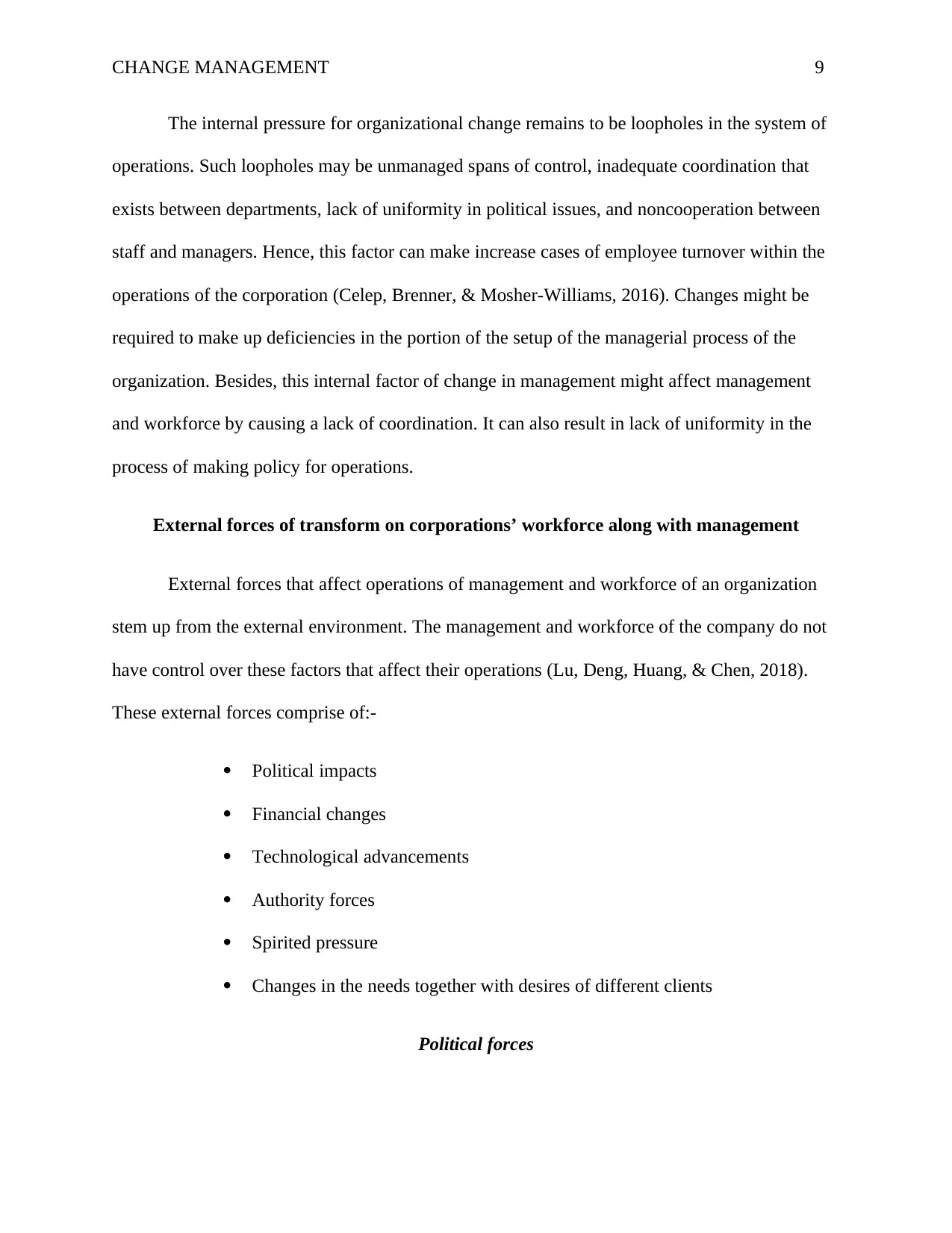
CHANGE MANAGEMENT 9
The internal pressure for organizational change remains to be loopholes in the system of
operations. Such loopholes may be unmanaged spans of control, inadequate coordination that
exists between departments, lack of uniformity in political issues, and noncooperation between
staff and managers. Hence, this factor can make increase cases of employee turnover within the
operations of the corporation (Celep, Brenner, & Mosher-Williams, 2016). Changes might be
required to make up deficiencies in the portion of the setup of the managerial process of the
organization. Besides, this internal factor of change in management might affect management
and workforce by causing a lack of coordination. It can also result in lack of uniformity in the
process of making policy for operations.
External forces of transform on corporations’ workforce along with management
External forces that affect operations of management and workforce of an organization
stem up from the external environment. The management and workforce of the company do not
have control over these factors that affect their operations (Lu, Deng, Huang, & Chen, 2018).
These external forces comprise of:-
Political impacts
Financial changes
Technological advancements
Authority forces
Spirited pressure
Changes in the needs together with desires of different clients
Political forces
The internal pressure for organizational change remains to be loopholes in the system of
operations. Such loopholes may be unmanaged spans of control, inadequate coordination that
exists between departments, lack of uniformity in political issues, and noncooperation between
staff and managers. Hence, this factor can make increase cases of employee turnover within the
operations of the corporation (Celep, Brenner, & Mosher-Williams, 2016). Changes might be
required to make up deficiencies in the portion of the setup of the managerial process of the
organization. Besides, this internal factor of change in management might affect management
and workforce by causing a lack of coordination. It can also result in lack of uniformity in the
process of making policy for operations.
External forces of transform on corporations’ workforce along with management
External forces that affect operations of management and workforce of an organization
stem up from the external environment. The management and workforce of the company do not
have control over these factors that affect their operations (Lu, Deng, Huang, & Chen, 2018).
These external forces comprise of:-
Political impacts
Financial changes
Technological advancements
Authority forces
Spirited pressure
Changes in the needs together with desires of different clients
Political forces
⊘ This is a preview!⊘
Do you want full access?
Subscribe today to unlock all pages.

Trusted by 1+ million students worldwide
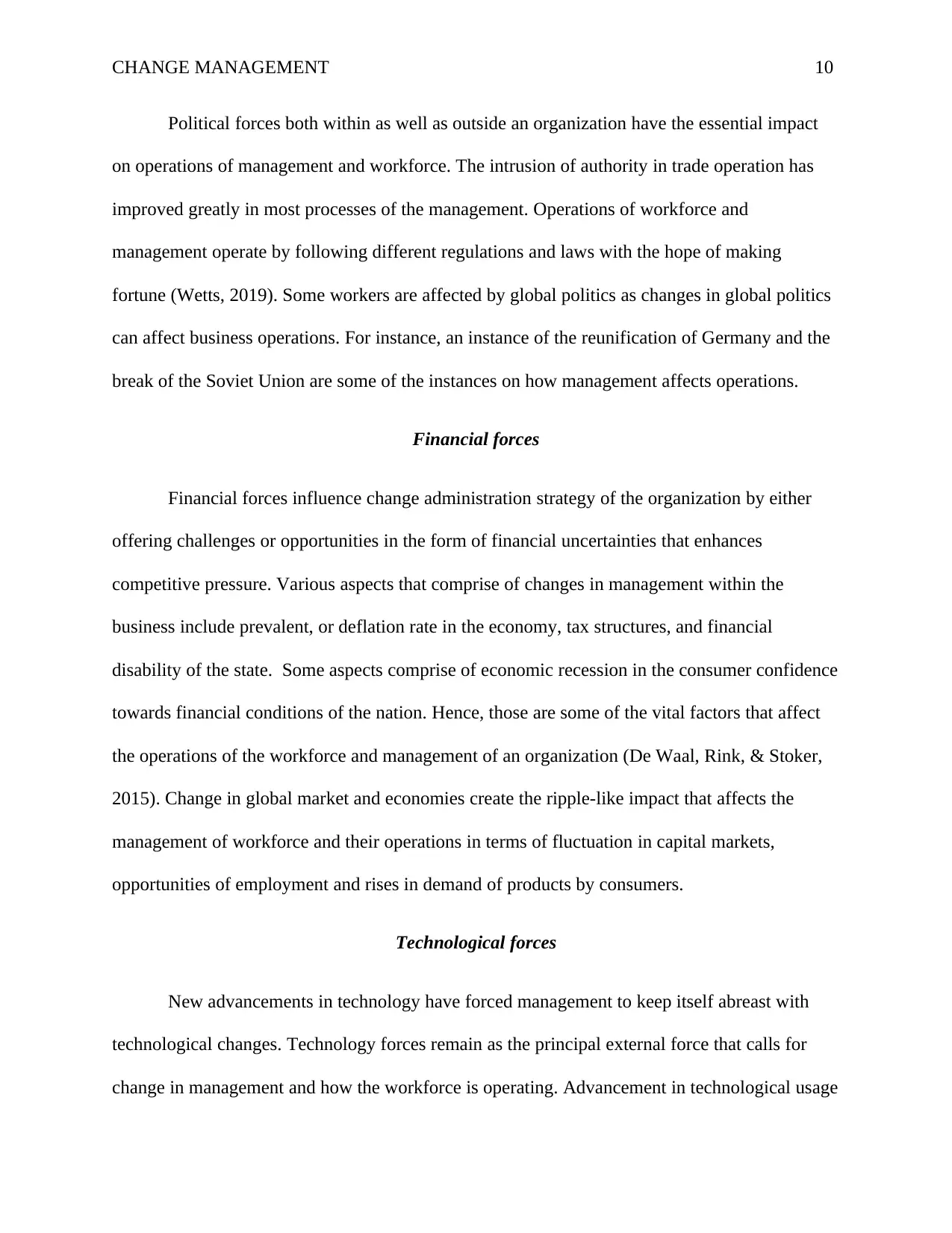
CHANGE MANAGEMENT 10
Political forces both within as well as outside an organization have the essential impact
on operations of management and workforce. The intrusion of authority in trade operation has
improved greatly in most processes of the management. Operations of workforce and
management operate by following different regulations and laws with the hope of making
fortune (Wetts, 2019). Some workers are affected by global politics as changes in global politics
can affect business operations. For instance, an instance of the reunification of Germany and the
break of the Soviet Union are some of the instances on how management affects operations.
Financial forces
Financial forces influence change administration strategy of the organization by either
offering challenges or opportunities in the form of financial uncertainties that enhances
competitive pressure. Various aspects that comprise of changes in management within the
business include prevalent, or deflation rate in the economy, tax structures, and financial
disability of the state. Some aspects comprise of economic recession in the consumer confidence
towards financial conditions of the nation. Hence, those are some of the vital factors that affect
the operations of the workforce and management of an organization (De Waal, Rink, & Stoker,
2015). Change in global market and economies create the ripple-like impact that affects the
management of workforce and their operations in terms of fluctuation in capital markets,
opportunities of employment and rises in demand of products by consumers.
Technological forces
New advancements in technology have forced management to keep itself abreast with
technological changes. Technology forces remain as the principal external force that calls for
change in management and how the workforce is operating. Advancement in technological usage
Political forces both within as well as outside an organization have the essential impact
on operations of management and workforce. The intrusion of authority in trade operation has
improved greatly in most processes of the management. Operations of workforce and
management operate by following different regulations and laws with the hope of making
fortune (Wetts, 2019). Some workers are affected by global politics as changes in global politics
can affect business operations. For instance, an instance of the reunification of Germany and the
break of the Soviet Union are some of the instances on how management affects operations.
Financial forces
Financial forces influence change administration strategy of the organization by either
offering challenges or opportunities in the form of financial uncertainties that enhances
competitive pressure. Various aspects that comprise of changes in management within the
business include prevalent, or deflation rate in the economy, tax structures, and financial
disability of the state. Some aspects comprise of economic recession in the consumer confidence
towards financial conditions of the nation. Hence, those are some of the vital factors that affect
the operations of the workforce and management of an organization (De Waal, Rink, & Stoker,
2015). Change in global market and economies create the ripple-like impact that affects the
management of workforce and their operations in terms of fluctuation in capital markets,
opportunities of employment and rises in demand of products by consumers.
Technological forces
New advancements in technology have forced management to keep itself abreast with
technological changes. Technology forces remain as the principal external force that calls for
change in management and how the workforce is operating. Advancement in technological usage
Paraphrase This Document
Need a fresh take? Get an instant paraphrase of this document with our AI Paraphraser
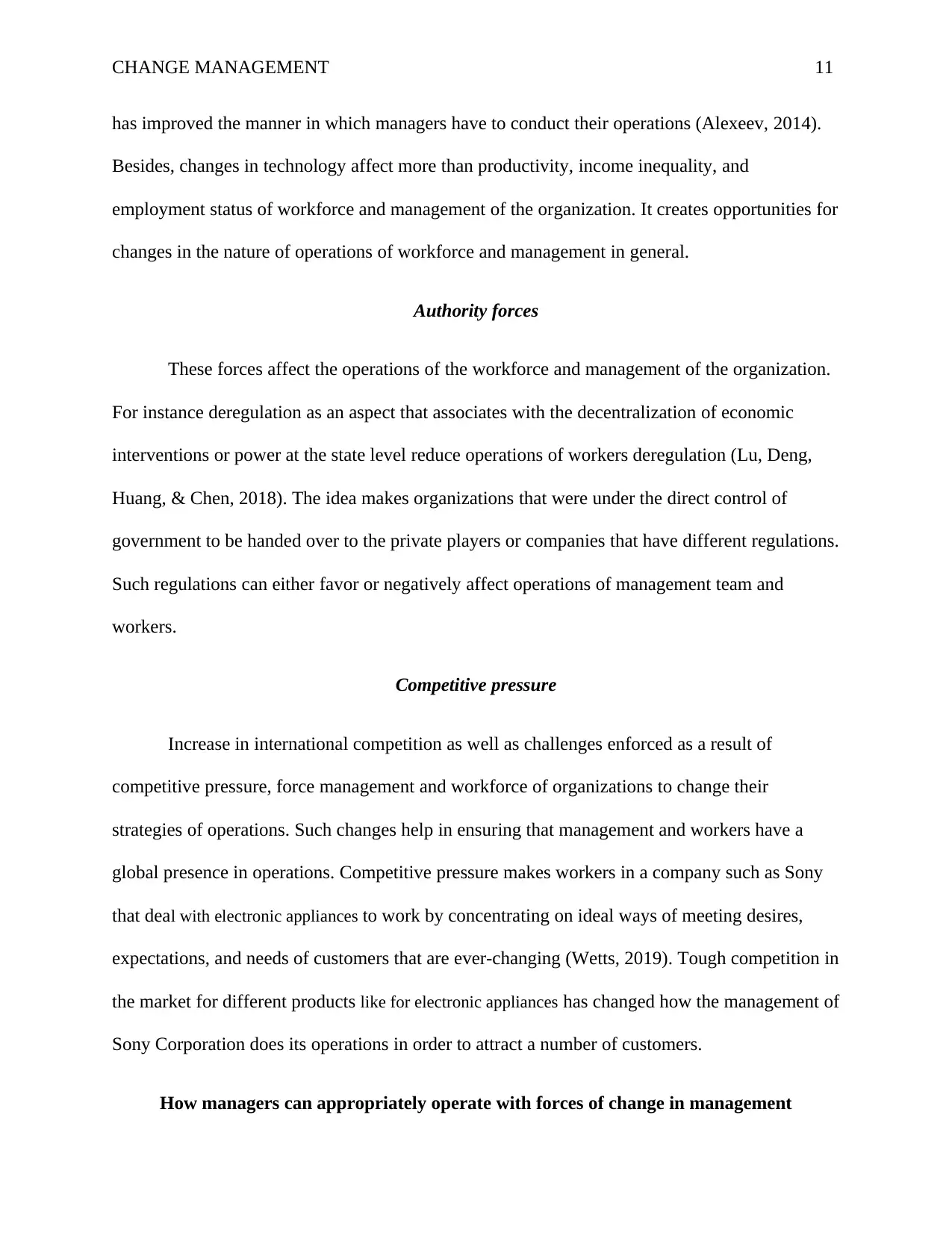
CHANGE MANAGEMENT 11
has improved the manner in which managers have to conduct their operations (Alexeev, 2014).
Besides, changes in technology affect more than productivity, income inequality, and
employment status of workforce and management of the organization. It creates opportunities for
changes in the nature of operations of workforce and management in general.
Authority forces
These forces affect the operations of the workforce and management of the organization.
For instance deregulation as an aspect that associates with the decentralization of economic
interventions or power at the state level reduce operations of workers deregulation (Lu, Deng,
Huang, & Chen, 2018). The idea makes organizations that were under the direct control of
government to be handed over to the private players or companies that have different regulations.
Such regulations can either favor or negatively affect operations of management team and
workers.
Competitive pressure
Increase in international competition as well as challenges enforced as a result of
competitive pressure, force management and workforce of organizations to change their
strategies of operations. Such changes help in ensuring that management and workers have a
global presence in operations. Competitive pressure makes workers in a company such as Sony
that deal with electronic appliances to work by concentrating on ideal ways of meeting desires,
expectations, and needs of customers that are ever-changing (Wetts, 2019). Tough competition in
the market for different products like for electronic appliances has changed how the management of
Sony Corporation does its operations in order to attract a number of customers.
How managers can appropriately operate with forces of change in management
has improved the manner in which managers have to conduct their operations (Alexeev, 2014).
Besides, changes in technology affect more than productivity, income inequality, and
employment status of workforce and management of the organization. It creates opportunities for
changes in the nature of operations of workforce and management in general.
Authority forces
These forces affect the operations of the workforce and management of the organization.
For instance deregulation as an aspect that associates with the decentralization of economic
interventions or power at the state level reduce operations of workers deregulation (Lu, Deng,
Huang, & Chen, 2018). The idea makes organizations that were under the direct control of
government to be handed over to the private players or companies that have different regulations.
Such regulations can either favor or negatively affect operations of management team and
workers.
Competitive pressure
Increase in international competition as well as challenges enforced as a result of
competitive pressure, force management and workforce of organizations to change their
strategies of operations. Such changes help in ensuring that management and workers have a
global presence in operations. Competitive pressure makes workers in a company such as Sony
that deal with electronic appliances to work by concentrating on ideal ways of meeting desires,
expectations, and needs of customers that are ever-changing (Wetts, 2019). Tough competition in
the market for different products like for electronic appliances has changed how the management of
Sony Corporation does its operations in order to attract a number of customers.
How managers can appropriately operate with forces of change in management
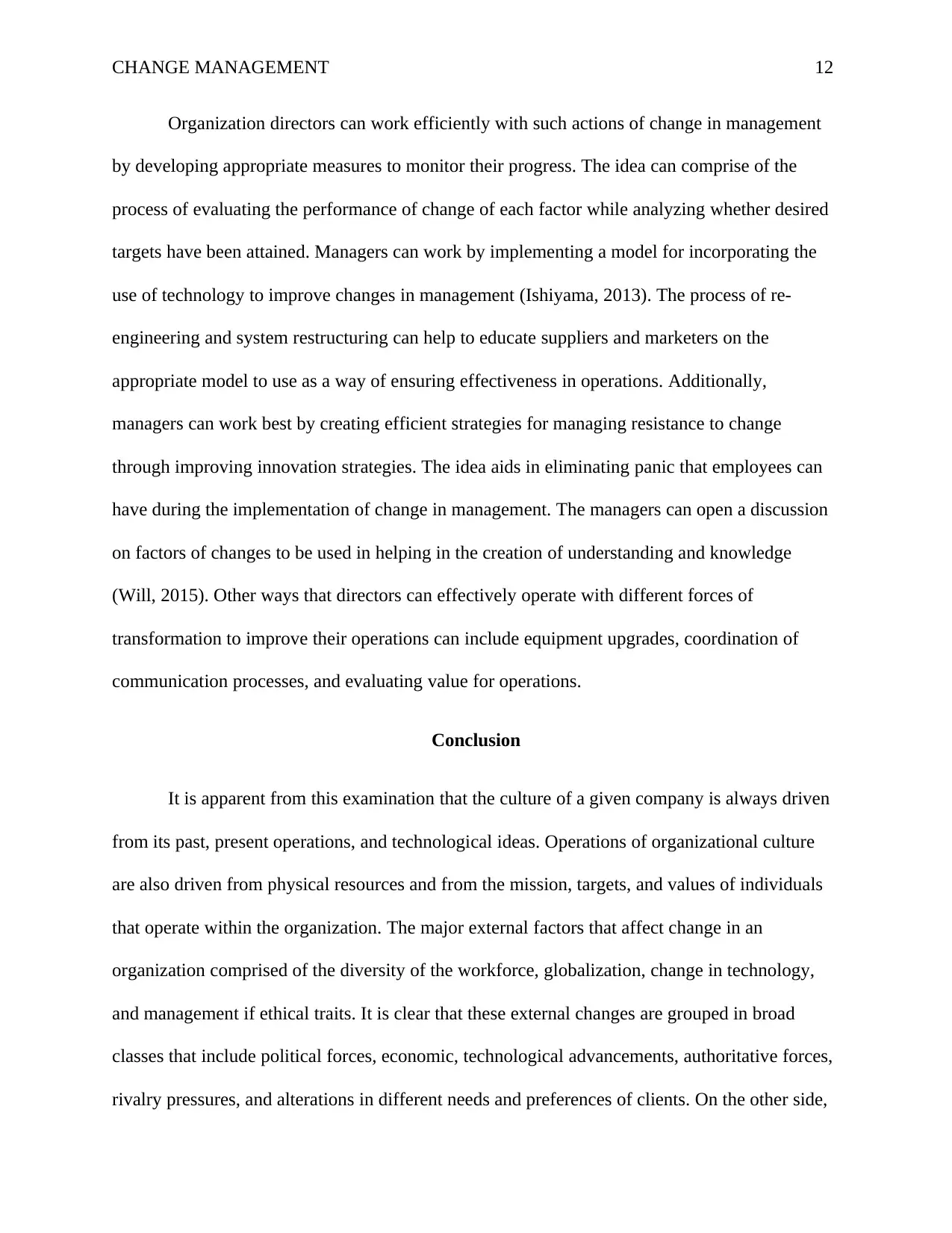
CHANGE MANAGEMENT 12
Organization directors can work efficiently with such actions of change in management
by developing appropriate measures to monitor their progress. The idea can comprise of the
process of evaluating the performance of change of each factor while analyzing whether desired
targets have been attained. Managers can work by implementing a model for incorporating the
use of technology to improve changes in management (Ishiyama, 2013). The process of re-
engineering and system restructuring can help to educate suppliers and marketers on the
appropriate model to use as a way of ensuring effectiveness in operations. Additionally,
managers can work best by creating efficient strategies for managing resistance to change
through improving innovation strategies. The idea aids in eliminating panic that employees can
have during the implementation of change in management. The managers can open a discussion
on factors of changes to be used in helping in the creation of understanding and knowledge
(Will, 2015). Other ways that directors can effectively operate with different forces of
transformation to improve their operations can include equipment upgrades, coordination of
communication processes, and evaluating value for operations.
Conclusion
It is apparent from this examination that the culture of a given company is always driven
from its past, present operations, and technological ideas. Operations of organizational culture
are also driven from physical resources and from the mission, targets, and values of individuals
that operate within the organization. The major external factors that affect change in an
organization comprised of the diversity of the workforce, globalization, change in technology,
and management if ethical traits. It is clear that these external changes are grouped in broad
classes that include political forces, economic, technological advancements, authoritative forces,
rivalry pressures, and alterations in different needs and preferences of clients. On the other side,
Organization directors can work efficiently with such actions of change in management
by developing appropriate measures to monitor their progress. The idea can comprise of the
process of evaluating the performance of change of each factor while analyzing whether desired
targets have been attained. Managers can work by implementing a model for incorporating the
use of technology to improve changes in management (Ishiyama, 2013). The process of re-
engineering and system restructuring can help to educate suppliers and marketers on the
appropriate model to use as a way of ensuring effectiveness in operations. Additionally,
managers can work best by creating efficient strategies for managing resistance to change
through improving innovation strategies. The idea aids in eliminating panic that employees can
have during the implementation of change in management. The managers can open a discussion
on factors of changes to be used in helping in the creation of understanding and knowledge
(Will, 2015). Other ways that directors can effectively operate with different forces of
transformation to improve their operations can include equipment upgrades, coordination of
communication processes, and evaluating value for operations.
Conclusion
It is apparent from this examination that the culture of a given company is always driven
from its past, present operations, and technological ideas. Operations of organizational culture
are also driven from physical resources and from the mission, targets, and values of individuals
that operate within the organization. The major external factors that affect change in an
organization comprised of the diversity of the workforce, globalization, change in technology,
and management if ethical traits. It is clear that these external changes are grouped in broad
classes that include political forces, economic, technological advancements, authoritative forces,
rivalry pressures, and alterations in different needs and preferences of clients. On the other side,
⊘ This is a preview!⊘
Do you want full access?
Subscribe today to unlock all pages.

Trusted by 1+ million students worldwide
1 out of 16
Related Documents
Your All-in-One AI-Powered Toolkit for Academic Success.
+13062052269
info@desklib.com
Available 24*7 on WhatsApp / Email
![[object Object]](/_next/static/media/star-bottom.7253800d.svg)
Unlock your academic potential
Copyright © 2020–2025 A2Z Services. All Rights Reserved. Developed and managed by ZUCOL.





